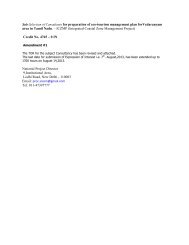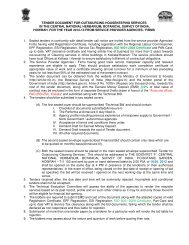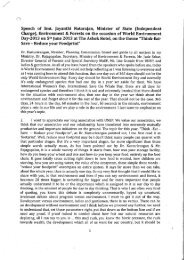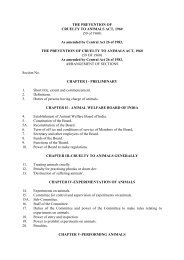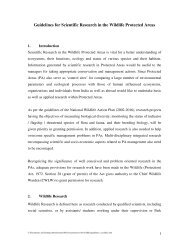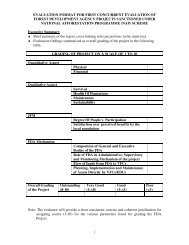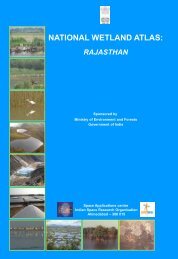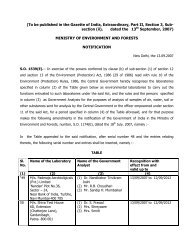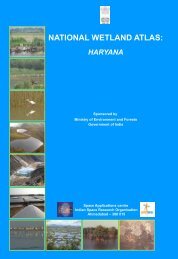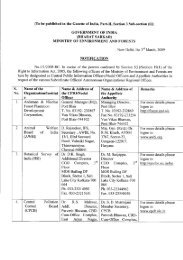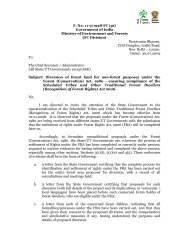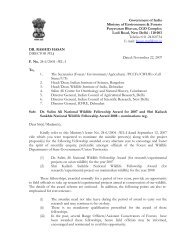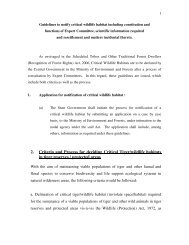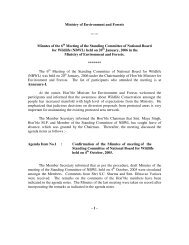lR;eso t;rs - Ministry of Environment and Forests
lR;eso t;rs - Ministry of Environment and Forests
lR;eso t;rs - Ministry of Environment and Forests
Create successful ePaper yourself
Turn your PDF publications into a flip-book with our unique Google optimized e-Paper software.
Desertification<br />
In India, 228.3 Mha. <strong>of</strong> geographical area comprises arid<br />
(50.8 Mha.), semi-arid (123.4 Mha.) <strong>and</strong> dry sub-humid regions<br />
(54.1 Mha.). Western parts <strong>of</strong> Rajasthan <strong>and</strong> Kutch are<br />
chronically drought affected. As a matter <strong>of</strong> fact, droughts occur<br />
frequently in the areas affected by desertification (Figure 2.1.5).<br />
Figure 2.1.5: Drought Prone Areas <strong>of</strong> India<br />
Source: State <strong>of</strong> <strong>Environment</strong> Atlas <strong>of</strong> India 2007, MoEF<br />
Pollution<br />
Box 2.1.1: Drive<strong>rs</strong> <strong>and</strong> Pressures Affecting Forest Ecosystems<br />
Population pressure, poverty <strong>and</strong> weak institutional framework have <strong>of</strong>ten been viewed as the predominant underlying causes<br />
<strong>of</strong> forest depletion <strong>and</strong> degradation in developing countries. Excessive population <strong>and</strong> livestock pressure <strong>and</strong> the requirements<br />
<strong>of</strong> forest products for essential development generate pressure on forest r<strong>eso</strong>urces like fuel-wood, fodder, timber, lumber, paper,<br />
which in turn trigge<strong>rs</strong> deforestation. Over-exploitation <strong>of</strong> the forest r<strong>eso</strong>urces, as compared to its incremental <strong>and</strong> regenerative<br />
capacities, escalates the forest depletion <strong>and</strong> degradation process. India has witnessed a spurt <strong>of</strong> large projects from big dams<br />
<strong>and</strong> thermal power projects to huge mines <strong>and</strong> massive industrial complexes. About 92 per cent area in arid Rajasthan is affected<br />
by desertification (30 per cent slightly, 41 per cent moderately <strong>and</strong> 21 per cent severely). In the neighbouring arid Gujarat, about<br />
93 per cent area is affected by desertification.<br />
Soil pollution from heavy metals due to improper disposal <strong>of</strong><br />
industrial effluents, along with the excessive use <strong>of</strong> pesticides<br />
<strong>and</strong> mismanagement <strong>of</strong> domestic <strong>and</strong> municipal wastes, is<br />
becoming a major concern. Though no reliable estimates are<br />
available to depict the exact extent <strong>and</strong> degree <strong>of</strong> this type <strong>of</strong> l<strong>and</strong><br />
degradation, it is believed that the problem is extensive <strong>and</strong> its<br />
effects are significant. Some commercial fertilize<strong>rs</strong> also contain<br />
appreciable quantities <strong>of</strong> heavy metals, which have undesirable<br />
effects on the environment. The indiscriminate use <strong>of</strong> agrochemicals,<br />
such as fertilize<strong>rs</strong> <strong>and</strong> pesticides, is <strong>of</strong>ten responsible<br />
for l<strong>and</strong> degradation. Soil texture, infiltration <strong>and</strong> permeability<br />
characteristics are affected adve<strong>rs</strong>ely to a considerable extent due<br />
to excessive grazing, fire <strong>and</strong> mismanagement <strong>of</strong> l<strong>and</strong> under<br />
cultivation.<br />
RESPONSE<br />
1. Wate<strong>rs</strong>hed management programmes have been taken up<br />
extensively in the recent past. The Soil <strong>and</strong> Water<br />
Conservation Division in the <strong>Ministry</strong> <strong>of</strong> Agriculture has<br />
been playing a key role in implementing Integrated<br />
Wate<strong>rs</strong>hed Management Programmes. IWDP (Integrated<br />
Wate<strong>rs</strong>hed Development Programme) was launched in the<br />
year 1989-90 to develop the wastel<strong>and</strong>s on wate<strong>rs</strong>hed basis,<br />
to strengthen the natural r<strong>eso</strong>urce base <strong>and</strong> to promote the<br />
overall economic development <strong>of</strong> the r<strong>eso</strong>urce-poor <strong>and</strong><br />
disadvantaged sections <strong>of</strong> people inhabiting the programme<br />
areas.<br />
2. The National Bureau <strong>of</strong> Soil Survey <strong>and</strong> L<strong>and</strong> Use Planning,<br />
the Central Soil <strong>and</strong> Water Conservation Research <strong>and</strong><br />
Training Institute <strong>and</strong> the Indian Council <strong>of</strong> Agricultural<br />
Research (ICAR), have jointly initiated the preparation <strong>of</strong><br />
maps <strong>of</strong> soil erosion affected areas in different states using the<br />
components <strong>of</strong> Unive<strong>rs</strong>al Soil Loss Equation. Similar<br />
assessments needs to be carried out for other degradation<br />
processes also. In addition, the All-India Soil <strong>and</strong> L<strong>and</strong> Use<br />
Survey, MoA, is engaged in generating spatial <strong>and</strong> nonspatial<br />
information on the soils <strong>of</strong> India <strong>and</strong> preparing<br />
Wastel<strong>and</strong> reclamation through Dhaincha plantation<br />
State & Trends <strong>of</strong> the <strong>Environment</strong>-L<strong>and</strong><br />
15



